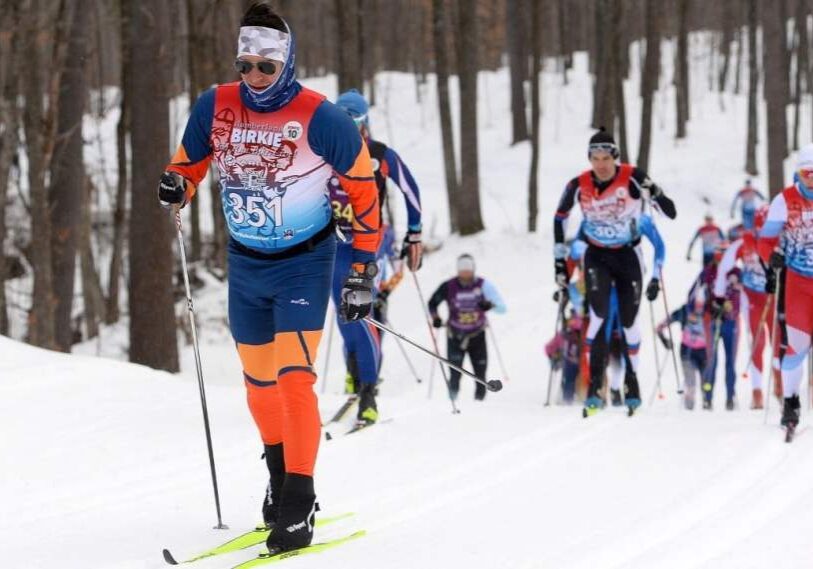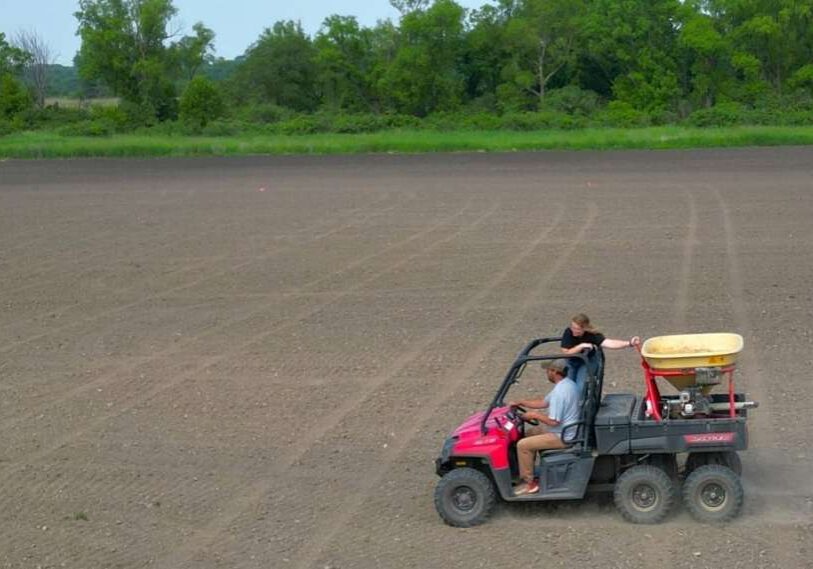Area Sheep Producer Boosts Productivity with Rotational Grazing

RUSHFORD — With rotational grazing and assistance from the USDA’s Natural Resources Conservation Service, Tom Scarponcini has improved the health of both livestock and land on his Winona County farm north of Rushford.
“If you can raise twice as many animals on the same limited number of acres, you have a distinct economic advantage,” Scarponcini said in mid-September while checking on his flock of Île-de-France sheep. “You can change poor pasture into lush pasture by managing the amount of time that the livestock are allowed to graze.”
Protected from coyotes by two attentive Maremma sheepdogs, 75 ewes grazed in a blufftop pasture. Scarponcini aims to expand the flock to 100 ewes. His setup — portable fencing within four permanently fenced paddocks to accommodate strip grazing on 20 acres — makes it easy to adjust for flock size and grass growth.
A renter grazes cattle on the farms remaining 275 acres of rotationally-grazed permanent pasture and grows corn and soybeans on 400 acres of tillable land. Woods cover another 160 acres.

Portable fencing allows Tom Scarponcini to more easily adjust his rotational grazing operation within four permanently fenced areas, moving the flock every one to three days during the grazing season.
“I have this philosophy that we’re really here borrowing this land from future generations, in that there is a moral obligation to leave it in at least as good a condition that you found it,” Scarponcini said.
“One of my goals is to leave the production ability of this farm in better condition than I found it. Rotational grazing will do that. You’re adding plant material to the soil to increase organic matter to make the soil more productive. You’re preventing erosion. You’re allowing the farm to be more productive, and it’s a really good way to control noxious weeds.”
Neighbors have asked how he’s controlled the thistles. Spraying? Mowing?
“I did neither. I fenced in the areas and made paddocks for rotational grazing. By allowing the grass the recovery time that it needed after a short period of grazing, the grasses were able to thrive and crowd out the weeds,” Scarponcini said.
Scarponcini started with an over-grazed, weed-choked operation. Over the span of 30 years, he has worked with grazing experts and with Environmental Quality Incentives Program (EQIP) assistance from NRCS to establish and fine-tune a rotational grazing system.
“They have just given me a tremendous amount of help in designing, cost-sharing, technical assistance and even the everyday management of the rotational grazing system,” Scarponcini said. “I’ve relied on them for their expertise. It has turned this farm around dramatically, from what I originally encountered when I moved here to what it is now. I would not have been able to do that without them.”

Moving the flock when grasses are 4 to 6 inches tall benefit the grasses with better root development, which in turn hold more water and pull in more nutrients.
Most recently, he’s worked with Dean Thomas, a Fillmore Soil & Water Conservation District-based regional grazing specialist and soil health technician whose territory covers 22 counties. Scarponcini had previously worked with Thomas and his predecessors to establish rotational grazing for his cattle.
Rotational grazing
When Scarponcini moved out of the cow-calf operation and expanded his flock, Thomas worked with him to convert cropland to rotationally-grazed pasture — which required seeding, fencing, establishing a water source and developing a management plan.
The goal: Move the flock out of the shed and onto grass to improve overall health and hoof health, and to give the sheep more exercise.
Scarponcini settled on a four-strand Poly Wire Gallagher fence (a portable fence made of wires embedded in plastic), with a strip-grazing type of setup and a portable water source.
NRCS assistance in 2022 offset part of the cost of installing about 5,670 feet of fencing and about 2,100 feet of surface pipeline that year. He seeded that pasture and added the portable water tanks on his own.
The management-intensive system requires moving the flock every one to three days. Strip-grazing makes it possible to adjust the grazed area to the growing season.
“The benefit is you should have grass in front of them all the time. You’re going to have better animal health. Your (animals) are going to be a lot quieter to work with. Their disposition is going to be fantastic most of the time because you’re moving them, you’re checking on them daily. And your herd health is going to be better because if you have any issues, you’re going to catch them in time,” Thomas said.

With assistance from NRCS, Tom Scarponcini installed over 5,000 feet of fencing and more than 2,000 feet of surface pipeline to establish a rotational grazing system for his flock of sheep.
Thomas explained how rotational grazing improves soil health: Turning the animals out onto 12-inch growth and moving them when the grasses are 4 to 6 inches tall allows regrowth and more well-developed root systems. Healthier plants pull in more nutrients and hold more water. Rotationally-grazed animals distribute manure more evenly.
The dense, perennial cover also helps to control wind and water erosion, which, in turn benefits water quality. Water from Scarponcini’s farm eventually flows to the Root River, a designated trout stream, and then to the Mississippi River.

Two Maremma sheepdogs protect the flock from coyotes.
“Your grasses are going to be filtering and catching all the nutrients so (they) don’t hit our rivers and streams and lakes,” Thomas said.
Scarponcini lists another benefit in addition to the economics, higher-quality fodder and erosion control:
“When you either graze or cut a plant, an equal amount of root system dies proportional to the amount of plant that you’ve harvested. As that root system dies, it adds organic matter to the soil and you end up with a soil that is richer, that has more water-holding capacity for times of drought, and better moves nutrients into plants.”

Scarponcini seeded the 20-acre pasture and installed the portable water source on his own.
Over the past couple of years, Thomas said he has seen increased interest in rotational grazing. For some, it is a way to extend the grazing season. For others, it is a way to make the most of available land. About 90% of the grazers he works with have off-the-farm jobs, which leaves little time for intensive management.“This (doesn’t) work for everybody. Some people just don’t have the time to do it. You have to have time to make this work, because if you don’t have time to move them and manage it, there’s no sense in moving forward,” Thomas said.
Scarponcini does have the time. He grew up in a Newark, New Jersey, suburb with aspirations — but no knowledge or experience — of raising livestock. Heeding his father’s advice to find a high-paying backup, he pursued interests in chemistry, biology and medicine. He became a pharmacist and a hobby farmer. Hobby farming eventually led him to Winona County and turned into a 250-head cow-calf operation, where sheep were a sideline at first.
By checking on his flock every day, Scarponcini has realized indirect benefits.
“You’re observing the grasses that are growing at your feet, the birds that are flying overhead, the wildlife that you see every single day. So it transforms what would otherwise be a job into a way of life,” Scarponcini said.
“The benefits are far beyond the financial return in doing that work. Just giving you an opportunity to see nature at work every single day — the rewards of that are anything beyond what you can put a price tag or a dollar value on,” he said.
“It’s a way of life.”
Dean Thomas, right, a Fillmore SWCD-based regional grazing specialist and soil health technician, visits with Tom Scarponcini about his grazing operation. Dean Thomas, a Fillmore SWCD-based regional grazing specialist and soil health technician, works directly with producers and trains conservation workers across a 22-county region. The following responses re edited for length. What’s one thing you wish people knew about rotational grazing? You don’t get results overnight. It’s just like switching from conventional tillage to minimum-till or no-till. It takes time. But over time you’re going to start seeing the benefits: better animal health. You’re going to have wildlife coming in. You’re going to have healthier soils, healthier grasses. If that cow moves into lush grass, even in July and August, if she’s milking good, that calf is gaining weight. What trends are you seeing? In the last couple of years, there has been a higher demand (from) people doing rotational grazing. Some of it’s repeat customers. We’re getting more bigger operations getting into it. I think a lot of them are looking at trying to extend their grazing season somehow, (some) with cover crops at the end (of the season), but most of them are looking at rotational grazing. The No. 1 issue we have in the whole state of Minnesota is everybody wants to have way more cattle than what they’ve got land to (support). I’d say a lot of our pastures are over-stocked. If they would cut back their stocking rates, they’ll be weaning probably at the same weight with less animals. By doing that, you’re going to be supplement feeding less, and you’ll be able to graze longer in the season. What’s the first question someone considering rotational grazing should ask? When do they have time to do this management? By setting up rotational grazing, you’re going to have to be managing and moving cattle. Once a week? This doesn’t work for everybody. Some people just don’t have the time to do it. You have to have time to make this work, because if you don’t have time to move (cattle) and manage (grazing), there’s no sense in moving forward.Three Questions with Dean Thomas







